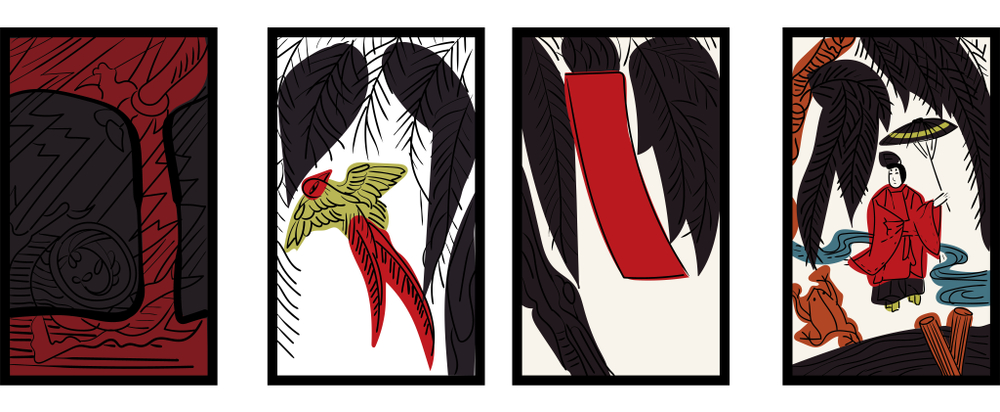Hanafuda cards are not just playing cards; they are a gateway to understanding Japanese nature and culture, serving as a kind of calendar that reveals the richness of traditions and symbolism. Each image on these cards offers a glimpse into Japanese festivals and natural phenomena, full of deep meaning. Join us as we uncover the wonders of this amazing tradition and see how each image reflects unique events and seasons in Japanese culture.
January: Pine (松, Matsu) and New Year (正月, Shōgatsu)

The pine tree, symbolizing longevity and resilience, plays a key role in celebrating New Year in Japan. The New Year, or Shōgatsu, is the most important holiday, and pine becomes an essential part of it. Streets and homes are decorated with kadomatsu—traditional New Year decorations made from pine branches, bamboo, and fern. This combination symbolizes wishes for health, longevity, and good fortune in the coming year. Kadomatsu is placed at the entrance to welcome the New Year and protect the home from evil spirits. During the holiday, Japanese people also visit temples to pray for prosperity and luck in the new year.
February: Plum (梅, Ume) and Plum Blossom Festival (梅の節句, Ume no sekku)

The Plum Blossom Festival, or Ume no sekku, is celebrated in February when plums begin to bloom. This festival marks the arrival of spring and symbolizes renewal in nature. Plum blossoms are associated with purity, strength of spirit, and longevity. During Ume no sekku, Japanese people enjoy the beauty of blooming trees, have picnics, and participate in traditional tea ceremonies. This time is often accompanied by poetry readings and other cultural activities, reflecting the elevated nature of this period.
March: Cherry Blossom (桜, Sakura) and Hanami (花見)

Hanami, which means “flower viewing,” is one of Japan’s most famous festivals, celebrating the cherry blossoms. Cherry blossoms symbolize the fleeting and delicate beauty of life. During Hanami, Japanese people gather under blooming cherry trees, have picnics, sing songs, and drink sake. This festival attracts people of all ages and backgrounds, creating a sense of community and joy. Hanami emphasizes the importance of enjoying the moment and valuing beauty in life, despite its transience. Celebrating Hanami allows people to connect with nature and each other, creating unforgettable memories of unity with the beautiful moment.
April: Wisteria (藤, Fuji) and Wisteria Festival (藤の宴, Fuji no utage)

Wisteria, one of the most beautiful and elegant flowers, symbolizes grace and femininity. In April, when wisteria begins to bloom, Japan holds festivals dedicated to this flower. One of the most famous wisteria festivals takes place in Ashikaga Flower Park in Tochigi Prefecture. In late April and early May, the park transforms into a paradise for flower lovers, featuring long arches and tunnels covered with blooming wisteria. This time of year attracts many visitors who enjoy not only the visual beauty but also the delicate fragrance of the flowers. Some festivals also include workshops on traditional Japanese arts and culinary events where you can taste local dishes made with seasonal ingredients. The Wisteria Festival offers a chance to immerse in the atmosphere of spring renewal and enjoy a moment of tranquility and beauty.
May: Iris (菖蒲, Ayame) and Iris Festival (菖蒲の節句, Ayame no sekku)

Iris, a flower symbolizing courage and strength of spirit, blooms in May, leading to the Iris Festival or Ayame no sekku. This festival is linked to the tradition of growing irises in wetlands, especially in gardens and ponds where these flowers showcase their beauty. In Tokyo, the Meiji Jingu Park hosts an annual Iris Festival where visitors can see many varieties of these beautiful flowers. The irises bloom in June, making the park a popular destination during this time. The celebration includes art and craft exhibitions related to irises, as well as demonstrations of traditional Japanese crafts and cuisine, offering a deep dive into Japanese culture and values.
June: Peony (芍薬, Shakuyaku) and Peony Festival (芍薬の節句, Shakuyaku no sekku)

The peony symbolizes strength and courage, and its blooming in June is celebrated in Japan with great enthusiasm. The Peony Festival, or Shakuyaku no sekku, is held at the Toshogu Shrine in Ueno, Tokyo. In April and May, when the peonies are in full bloom, the shrine’s gardens are decorated with bright and lush flowers, creating a stunning sight. This festival attracts many people who come to admire the flowers. The festival often includes workshops on making floral arrangements and demonstrations of traditional Japanese crafts. The Peony Festival is not just a celebration of beauty but also an opportunity to honor the strength and courage symbolized by these magnificent flowers.
July: Clover (クローバー, Kurōbā) and Clover Festival (クローバーの節句, Kurōbā no sekku)

Clover, often associated with luck and happiness, holds a special place in Japanese culture. In July, when clover is in bloom, Japan hosts small but vibrant festivals dedicated to this humble flower. One such event is the Clover Festival, or Kurōbā no sekku. At these festivals, you can see not only traditional decorations and clover arrangements but also actively participate in the celebrations. Clover fairs offer local products and crafts made from this plant. Workshops on growing clover allow participants to learn more about its cultivation. There are also bouquet contests and cooking classes. These festivals attract both locals and tourists who want to immerse themselves in an atmosphere of happiness and luck.
August: Susuki (すすき, Susuki) and Obon (お盆)

Susuki, or Japanese pampas grass, symbolizes autumn and the harvest season. In August, during Obon—a Buddhist festival dedicated to honoring ancestors—susuki plays an important role in rituals and decorations. Obon lasts three days and is a time when it is believed that the spirits of the deceased return to visit their families. During the festival, traditional Bon Odori dances are held, helping people connect with the spirits and express gratitude for their lives. In the evenings, paper lanterns are floated on water to guide the spirits back to the world of the dead.
September: Chrysanthemum (菊, Kiku) and Chrysanthemum Festival (菊の節句, Kiku no sekku)

Chrysanthemum in Japan symbolizes longevity, perfection, and its connection with the imperial family. In September, when chrysanthemums are in bloom, festivals celebrating this flower take place. One of the most famous festivals is held at Yushima Tenmangu Shrine in Tokyo. In November, you can see over 2,000 flowers of 32 different varieties grown by members of the Bunkyo Chrysanthemum Society. These festivals attract around 100,000 visitors each year. At the festivals, you can enjoy the beauty of chrysanthemums and see the skill of gardeners creating amazing displays and arrangements. The Chrysanthemum Festival is a chance to appreciate the beauty and diversity of this flower and to honor its significance as a symbol of longevity and perfection.
October: Maple (楓, Kaede) and Momidzigari (紅葉狩り)

In October, as maple leaves change to bright shades of red, orange, and yellow, Japanese people celebrate Momidzigari, or autumn leaf hunting. This tradition attracts many people who want to enjoy the beauty of the fall scenery. Maple trees during this time are covered in rich, warm colors, creating picturesque landscapes that are breathtaking. One of the most popular places to view the autumn leaves is the Todai-ji Temple complex in Nara. This ancient temple is surrounded by extensive gardens and forests where maple trees create stunning views, especially when their leaves turn vibrant fall colors. People often have picnics under the maple trees, enjoying the quiet and beauty of the autumn nature. Momidzigari is not only a chance to admire the fall landscapes but also a time for deep reflection and inner peace. Picnics under the maple trees create a cozy and serene atmosphere, allowing people to immerse themselves in the beauty of nature and feel the transition from summer warmth to cool autumn.
November: Rain (雨, Ame) and Kitsune no Yume (狐の夢)

November in Japan is known for frequent rains that bring a refreshing atmosphere and create a special mood. This month inspires the creation and reimagining of Japanese legends, such as Kitsune no Yume, or “The Fox’s Dream.” According to ancient Japanese belief, a fox sleeping in the rain dreams of magical flowers and enchanted worlds hidden from ordinary sight. These flowers symbolize beauty and wonders that lie beyond everyday life.
During this season, rain is seen as a metaphor for cleansing and renewal. Japanese people often spend cozy evenings with family, preparing traditional warming dishes like o-deko (roasted sweet potatoes) and ramen. The rain creates a feeling of seclusion and peace, encouraging people to reflect on the hidden aspects of life. Walking in the rain or staying at home in a warm setting helps with deep reflection and inner cleansing, allowing people to appreciate the beauty of the hidden world and find harmony in daily life.
December: Paulownia (桐, Kiri) and New Year (正月, Shōgatsu)

In December, it’s time to prepare for New Year celebrations, and paulownia becomes an important symbol of this time. Paulownia, with its elegant leaves and flowers, is associated with rebirth and new beginnings. In Japanese culture, it is often depicted with the phoenix, symbolizing immortality and eternal renewal.
In some regions of Japan, paulownia is used in New Year decorations, such as kadomatsu—traditional arrangements of pine branches, bamboo, and paulownia placed at the entrances of homes. These decorations are meant to attract good fortune and protect against evil spirits, symbolizing the start of a new cycle and hope for a better future. New Year celebrations, or Shōgatsu, involve various traditions. Japanese people clean their homes, prepare special food like osechi-ryōri (traditional New Year dishes), and visit shrines to pray for prosperity and good luck in the new year. Paulownia, in this context, represents hope and renewal, reflecting the fresh start and new beginning that the New Year brings.
Hanafuda: A Reflection of Japanese Culture
Hanafuda cards are more than just playing cards; they are a mirror reflecting the soul of Japanese culture, its subtle nuances, and deep philosophy. Each card, like a mosaic piece, reveals the grandeur of nature and the beauty of the human spirit. Exploring the symbolism of Hanafuda becomes a journey into Japanese aesthetics and wisdom hidden in the flowers and symbols.
Through time and space, Hanafuda guides us through the circle of seasons, from the green of spring to the gold of autumn, unveiling an inner world where harmony and balance are central. These cards are a path to understanding how humanity is connected to the eternal cycle of nature and how our inner state reflects the outer world. Each card captures not only beauty but also profound philosophical truths that help us grasp the essence of existence.
Looking at Hanafuda, we enter a world where every symbol is filled with secret meaning, and each image becomes a bridge between the visible and the invisible, the real and the mystical. It is an invitation to meditation and self-discovery, to uncover the treasures of the inner world and explore new horizons. By traveling this path, we gain understanding not only of ourselves but also of the surrounding world, exploring the endless facets of human experience and the depths of nature.
Hanafuda is a key to ancient Japanese wisdom and spirit, enriching our lives and illuminating the path to self-discovery and inner enlightenment.
#hanafuda #hanafudamonths #hanafudacards #harmonyseasons #japanesecalendar


